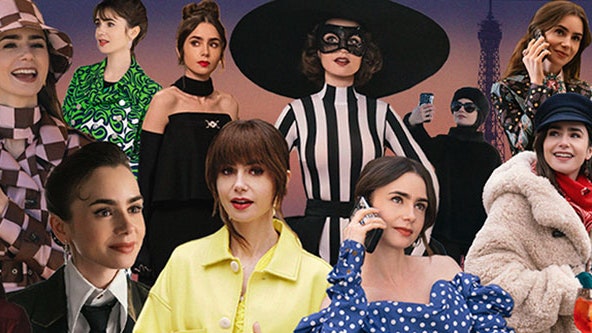Season four features labels such as Carven, Vivienne Westwood, Jacquemus, Ganni, Ralph Lauren and Nina Ricci. The show has birthed scores of Instagram accounts like @EmilyInParisOutfits (170,000 followers), @LilyCollinsStyle (31,900 followers) and @EmilyInParisOutfit (25,600 followers), which break down and identify looks from the show. On TikTok, there are seven million posts featuring the term “Emily in Paris clothes”. To capitalise on demand, Netflix teamed up with Google Lens this season to allow fans to use the image recognition technology to shop looks or find similar pieces to those featured in the show.
On global shopping platform Lyst, searches for “Jacquemus cardigans” are up 18 per cent month-on-month, while searches for “Ganni bags” are up 15 per cent month-on-month from August to September. Searches for styles worn in the show like “sailor caps” and “checked coats” are up 46 per cent and 53 per cent, respectively.
It’s not just the show itself: Collins wore Cartier during the Emily in Paris press tours and red carpet premieres, as well as on the September issue of Harper’s Bazaar Australia and on the August cover of Harper’s Bazaar Thailand while promoting the show, generating 57.6 million engagements and $2.3 million in earned media value for the high jewellery maison, according to influencer analytics platform WeArisma.
Organic storytelling
Emily in Paris has also found success in going beyond product placement and integrating brands into its storylines. The showrunners largely select brands beloved by themselves, the cast and the crew, to feature in the show, resulting in organic exposure.
In episode one of season four, for example, character Mindy Chen (Ashley Park) resells a pink couture look gifted by her rich boyfriend (the heir to fictional conglomerate JVMA), in order to fund her upcoming Eurovision performance. She walks into a heavily branded (fictional) Vestiaire Collective resale concession store, where she’s offered €3,000 for the outfit. Emily in Paris costume director Marylin Fitoussi regularly sources pieces from Vestiaire for the show IRL, the platform says, so the partnership evolved naturally.
The Emily in Paris partnership is part of Vestiaire Collective’s broader strategy to grow its presence in the American market, which today represents 20 per cent of sales, says Vestiaire Collective co-founder and CEO Fanny Moizant. “Vestiaire Collective’s feature in [Emily in Paris] positions the company as a trusted fashion authority and brings our message to an audience passionate about fashion,” Moizant adds.


